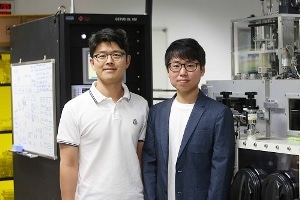Aug 28 2018
In recent times, the power conversion efficiency (PCE) of colloidal quantum dot (CQD)-based solar cells has been improved, making way for their commercialization in several fields; however, they are still far from being commercialized because of their efficiency not corresponding to their stability. In this study, a KAIST team created very stable and efficient CQD-based solar cells by employing an amorphous organic layer to block oxygen and water permeation.
 From left: Professor Jung-Yong Lee and Dr. Se-Woong Baek (Image credit: KAIST)
From left: Professor Jung-Yong Lee and Dr. Se-Woong Baek (Image credit: KAIST)
CQD-based solar cells are flexible, light-weight, and they enhance light harvesting by absorbing near-infrared lights. Particularly, they have gained attention for their optical properties manipulated efficiently by altering the quantum dot sizes. However, they are still mismatched with current solar cells in terms of stability, efficiency, and cost. Thus, there is a huge demand for a novel technology that can concurrently enhance both PCE and stability while using a low-cost electrode material.
Acknowledging this demand, Professor Jung-Yong Lee from the Graduate School of Energy, Environment, Water, and Sustainability and his team launched a technology to enhance the stability and efficiency of CQD-based solar cells.
The team discovered that an amorphous organic thin film has a robust resistance to water and oxygen. Using these properties, they used this doped organic layer as a top-hole selective layer (HSL) for the PbS CQD solar cells, and established that the hydro/oxo-phobic properties of the layer efficiently safeguarded the PbS layer. According to the molecular dynamics simulations, the layer considerably postponed the water and oxygen permeation into the PbS layer. Furthermore, the efficient injection of the holes in the layer lowered interfacial resistance and enhanced performance.
With this technology, the team, at last, developed CQD-based solar cells with superior stability. The PCE of their device calculated at 11.7% and maintained more than 90% of its original performance when stored in ambient conditions for one year.
Professor Lee said, “This technology can be also applied to QD LEDs and Perovskite devices. I hope this technology can hasten the commercialization of CQD-based solar cells.”
This study, directed by Dr. Se-Woong Baek and a Ph.D. student, Sang-Hoon Lee, was reported in Energy & Environmental Science on May 10th.